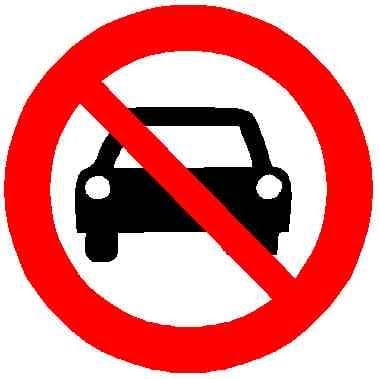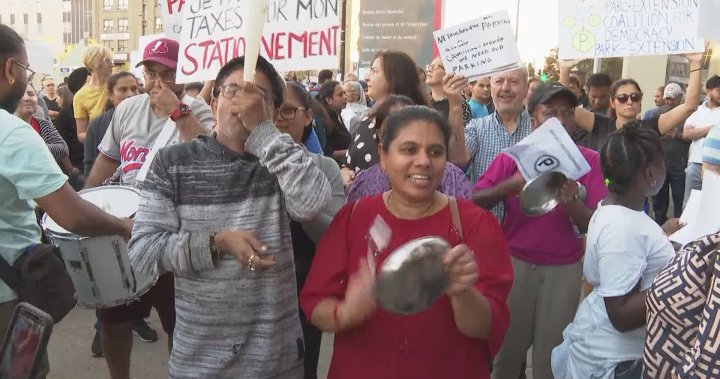Montreal is easily one of the most bike-friendly cities in North America, and yet even here we have carbrains who feel perpetually entitled to 250 parking spaces (the amount removed for the new bike lane) over the needs of everyone else. Clearly someone felt so strongly entitled to their parking that they threw thumbtacks in the new bike lane.
When people tell you there’s a war on cars, it’s projection. There’s a war on anybody and everybody not in a car.
Technically since wars have two sides. That does mean there is also a war against cars. It’s just that the cars have been winning for a while.
deleted by creator
Okay, the loss is 250, but of how many?
I can’t find a fixed value for the number of spaces in the Burrough, however this CBC article suggests that 29.8% of the Burrough is parking (bike lanes are 2%).
The burrough is 16.5km^2. Therefore 4.917 km^2 is parking. Parkingindustry.ca offers 8" x 16" as the average parking space in Canada, which is 0.000011891589 km^2. I’m going to round up to 0.00002 km^2 to make math easier and absorb non-stall area of parking lots.
That gives us at least 245,850 parking spots in the Burrough. So the percentage of parking lost is 0.1%.
Villeray–Saint-Michel–Parc-Extension resident parking permits cost $100 for most cars.
Is that 29.8% the percent of total land or the percent of total street space? The article’s wording is kind of vague.
As an aside, I also find it very frustrating how one woman quoted in the article said this:
“When you’re doing a project like the bike lane, have a compromise in mind,” Bailakis said in an interview outside. “Why do the old people, kids, families get booted out [of the conversation] just to please one people: the bike people?”
It’s such a gross way to portray the topic. They just automatically assume the car as default and treat bikes like some thing that only the “bike people” use. I might ask her why she believes my sister, who had her driver’s license suspended because of a medical condition, doesn’t deserve the same rights as those physically fit to drive. My sister can ride a bike just fine, but just can’t drive, and yet car-dependent urban design strips her of what ought to be equal rights to mobility.
“Why do the old people, kids, families get booted out [of the conversation] just to please one people: the bike people?”
How are old people and children benefitting from cars over bikes???
Clearly children and the elderly are literally physically incapable of using any mode of transit besides a car, thus our car-dependent hellscape is actually an act of charity out of the pure goodness of our hearts!!
/s
I love knowing that children and the elderly make up a large percentage of drivers.
Is that 29.8% the percent of total land or the percent of total street space? The article’s wording is kind of vague.
Dunno, I assumed total area, and balanced that by giving nearly half the area to “parking area” that didn’t count towards the number of stalls.
I haven’t been up there, so I don’t know that the burrough is like. I’d also be unlikely to see anything not within 1km of a metro station even if I did go, so my view would be biased anyways.
Alternatively, the population of the burrough is 143,85, so they are removing one stall for every 575 residents (all residents, not just driving residents).
“No one is against secure bike paths,” Spanoudakis said in a recent interview. “The point of contention is why does this need to be done with the removal of 250 parking spots, which (is) going to impact the quality of life in the neighbourhood?”
Spanoudakis distanced herself from the acts of vandalism targeting bike paths, but said the borough’s plan to eliminate parking for bike paths has polarized the community. “We clearly feel that we are being pitted against the needs of the cyclists and it shouldn’t be that.”
Cyclists subsidize motorists. Cyclists pay more into the system than they cost, motorists pay far far less. The needs of cyclists should always come before the needs of motorists. That is just basic decency and fairness.
Spot on. Like that saying goes, when you’re accustomed to privilege, equality feels like oppression.
I would argue that’s overly simplistic. In Melbourne, where I’m from, cycling infrastructure is passable in the inner city suburbs where house prices
average well over a million dollarsvery high, and effectively only available to wealthier people. The outer suburbs, where there is no cycling infrastructure and limited public transport but affordablish housing, life is such that cars are necessary.In cases such as this, motorists subsidizing cyclists is the rich being subsidized by the poor. I would far prefer a system where cyclists (and public transit) are subsidized by the rich, and longer term plans are implemented to remove the mandate of cars to the working poor, which in my example would mean current cyclists funding current motorists (with an intention to convert them to former motorists).
I don’t see how this addresses my point so allow me to restate it. When there is a conflict or compromise over limited resources between a vulnerable class of travelers that pay more than their own way and a privileged class that enjoy public subsidy, the former class should clearly receive priority. What is the conflict you are trying to highlight, where everyone’s needs could not be met if Melbourne cared to try?
Right, your statement that currently cyclists subsidized driver’s isn’t being disputed, nor is the fact that cars cost more to service associated infrastructure (as for some reason other replies are arguing).
My point is that in many places, cycling is only an option for the wealthy due to a lack of infrastructure in poorer areas. Melbourne could meet everyone’s needs if it cared to try, however it currently does not, which is to the detriment of the the less privileged and that is the point I am making.
Relative to motor vehicles cyclists cause zero damage to roads. All pay taxes. Motorists are therefore subsidized by cyclists.
Melbourne’s bike network is extensive and goes through many areas of the city. Not just to million dollar homes.
Many people ride bikes because they can’t afford cars.
Suburbia is further subsidized by cities and North American suburbs should never have existed in the way that they do.
Everything about your logic is backwards and focused on car drivers and suburbanites experiencing no discomfort during a transition to sustainability while all discomfort is placed on others.
Relative to motor vehicles cyclists cause zero damage to roads. All pay taxes. Motorists are therefore subsidized by cyclists.
This is not at all in dispute.
Melbourne’s bike network is extensive and goes through many areas of the city. Not just to million dollar homes.
I don’t agree with this. The inner suburbs have good bike lanes, places like pakenham or cragieburn do not. I admit the million dollar number was a bad way of phrasing what I actually mean (and distracts because it’s a wrong claim), which is unaffordable. Yes you can safely ride from like glenroy which is well connected with bike lanes, but family homes in glenroy exceed $800k which is ludicrous for a low income family.
Many people ride bikes because they can’t afford cars.
Absolutely. Many others drive cars because they can’t afford to live close enough to the city for riding to be safe and practical. Different housing needs drive different outcomes here.
Suburbia is further subsidized by cities and North American suburbs should never have existed in the way that they do.
Absolutely agree. However they do and a conscious, deliberate effort is needed over time to correct this.
Everything about your logic is backwards and focused on car drivers and suburbanites experiencing no discomfort during a transition to sustainability while all discomfort is placed on others.
A lot of your points I unreservedly agree with, so if you feel they have anything to do with my logic then your contradicting yourself. In your whole.paragraph there’s only a single point that I don’t agree with.
It’s not clear to me where the people who are all for bike lanes but also want the parking spaces to stay think the space for bike lanes is going to come from. We aren’t Time Lords, we can’t just fold a few extra feet of space into there. So what is it that they actually want?
One day this summer, all the Bixi rent-a-bikes had their tires slashed in my neighborhood.
So next someone will do it to cars.
I’mma start chucking thumbtacks in car lanes then.
Thumbtacks won’t pierce the walls. Two inch nails with rubber bands wrapped around the bottom creating a base might do something like that, but that’d be wrong and illegal and a silly idea that’ll get you some unwanted attention
Hypothetically speaking, I think tetrahedral caltrops would work better.
I’m trying to picture this contraption you describe (for educational, completely non-practical reasons of course), where does the cotton and rubber bands go?
Opposing motorism AND freeing chickens from captivity. Good instructable!
Cotton was a typo, meant bottom. !0------- there you go
Wouldn’t that angle the tip downward though? Unless you were hand placing them upward
That’s how i got a flat once when I drove away after parking in a sketchy place.
hope the quebecoise respond with caltrops on the adjacent roads

I would just laugh at their lack of knowledge. My tires are filled with a tubeless compound that fills holes. Anything short of a sidewall blowout barely slows me down.
When you are laughing, watch out for wire strung across the trail, that is always the next escalation.
I’ve heard of hunters placing wires strung across MTB trails at neck height. In Spain several people have died or become tetraplegic due to them. You can’t see the wire in time to do anything about it.
It is common all over the world. We all have basically the same monkey brain, we all have the same stupid ideas. It’s the good ones that are rare.







